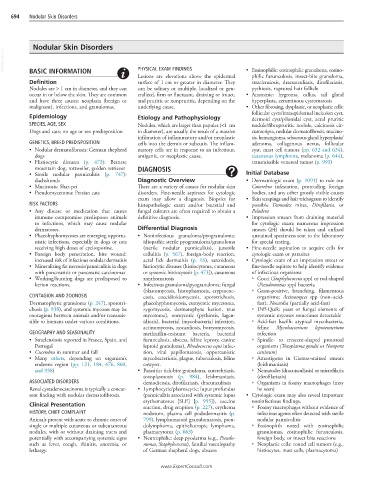Page 1378 - Cote clinical veterinary advisor dogs and cats 4th
P. 1378
694 Nodular Skin Disorders
Nodular Skin Disorders
VetBooks.ir
PHYSICAL EXAM FINDINGS
BASIC INFORMATION
philic furunculosis, insect-bite granuloma,
Lesions are elevations above the epidermal • Eosinophilic: eosinophilic granuloma, eosino-
Definition surface of 1 cm or greater in diameter. They straelensiosis, dracunculiasis, dirofilariasis,
Nodules are > 1 cm in diameter, and they can can be solitary or multiple, localized or gen- pythiosis, ruptured hair follicle
occur in or below the skin. They are common eralized, firm or fluctuant, draining or intact, • Anatomic: hygroma, callus, tail gland
and have three causes: neoplasia (benign or and pruritic or nonpruritic, depending on the hyperplasia, ceruminous cystomatosis
malignant), infections, and granulomas. underlying cause. • Other fibrosing, dysplastic, or neoplastic cells:
follicular cysts/intraepidermal inclusion cyst,
Epidemiology Etiology and Pathophysiology dermoid cyst/pilonidal cyst, acral pruritic
SPECIES, AGE, SEX Nodules, which are larger than papules (<1 cm nodule/fibropruritic nodule, calcinosis cir-
Dogs and cats; no age or sex predisposition in diameter), are usually the result of a massive cumscripta, nodular dermatofibrosis, mucino-
infiltration of inflammatory and/or neoplastic sis, hemangioma, sebaceous gland hyperplasia/
GENETICS, BREED PREDISPOSITION cells into the dermis or subcutis. The inflam- adenoma, collagenous nevus, follicular
• Nodular dermatofibrosis: German shepherd matory cells are in response to an infectious, cyst, mast cell tumors (pp. 632 and 634),
dogs antigenic, or neoplastic cause. cutaneous lymphoma, melanoma (p. 644),
• Histiocytic diseases (p. 473): Bernese transmissible venereal tumor (p. 993)
mountain dog, rottweiler, golden retriever DIAGNOSIS
• Sterile nodular panniculitis (p. 747): Initial Database
dachshunds Diagnostic Overview • Dermatologic exam (p. 1091) to rule out
• Mucinosis: Shar-pei There are a variety of causes for nodular skin Cuterebra infestation, protruding foreign
• Pseudomycetoma: Persian cats disorders. Fine-needle aspirates for cytologic bodies, and any other grossly visible causes
exam may allow a diagnosis. Biopsies for • Skin scrapings and hair trichogram to identify
RISK FACTORS histopathologic exam and/or bacterial and possible Demodex mites, Dirofilaria, or
• Any disease or medication that causes fungal cultures are often required to obtain a Pelodera
immune compromise predisposes animals definitive diagnosis. • Impression smears from draining material
to infections, which may cause nodular for cytologic exam; numerous impression
dermatoses. Differential Diagnosis smears (≥4) should be taken and unfixed
• Phaeohyphomycoses are emerging opportu- • Noninfectious granuloma/pyogranuloma: unstained specimens sent to the laboratory
nistic infections, especially in dogs or cats idiopathic sterile pyogranuloma/granuloma for special testing.
receiving high doses of cyclosporine. (sterile nodular panniculitis), juvenile • Fine-needle aspiration to acquire cells for
• Foreign body penetration, bite wound: cellulitis (p. 567), foreign-body reaction, cytologic exam or parasites
increased risk of infectious nodular dermatitis acral lick dermatitis (p. 16), sarcoidosis, • Cytologic exam of an impression smear or
• Mineralizing fat necrosis/panniculitis in dogs histiocytic diseases (histiocytoma, cutaneous fine-needle aspirate to help identify evidence
with pancreatitis or pancreatic carcinomas or systemic histiocytosis [p. 473]), cutaneous of infectious organisms
• Working/hunting dogs are predisposed to xanthomatosis ○ Cocci (Staphylococcus spp) or rod-shaped
kerion reactions. • Infectious granuloma/pyogranuloma: fungal (Pseudomonas spp) bacteria
(blastomycosis, histoplasmosis, cryptococ- ○ Gram-positive, branching, filamentous
CONTAGION AND ZOONOSIS cosis, coccidioidomycosis, sporotrichosis, organisms: Actinomyces spp (non–acid-
Dermatophytic granuloma (p. 247), sporotri- phaeohyphomycosis, eumycotic mycetoma, fast); Nocardia (partially acid-fast)
chosis (p. 938), and systemic mycoses may be zygomycosis, dermatophyte kerion, true ○ Diff-Quik: yeast or fungal elements of
contagious between animals and/or transmis- mycetoma), oomycotic (pythiosis, lagen- systemic mycoses sometimes detectable
sible to humans under various conditions. idiosis), bacterial (mycobacterial infection, ○ Acid-fast bacilli: atypical mycobacteria,
actinomycosis, nocardiosis, botryomycosis, feline Mycobacterium lepraemurium
GEOGRAPHY AND SEASONALITY methicillin-resistant bacteria, bacterial infection
• Straelensiosis reported in France, Spain, and furunculosis, abscess, feline leprosy, canine ○ Spindle- to crescent-shaped protozoal
Portugal leproid granuloma), Rhodococcus equi infec- organisms (Toxoplasma gondii or Neospora
• Cuterebra in summer and fall tion, viral papillomatosis, opportunistic caninum)
• Many others, depending on organism’s mycobacteriosis, plague, tuberculosis, feline ○ Amastigotes in Giemsa-stained smears
endemic region (pp. 121, 184, 476, 860, cowpox. (leishmaniasis)
and 938) • Parasitic: tick-bite granuloma, cuterebriasis, ○ Nematodes (dracunculiasis) or microfilaria
toxoplasmosis (p. 984), leishmaniasis, (dirofilariasis)
ASSOCIATED DISORDERS demodicosis, dirofilariasis, dracunculiasis ○ Organisms in foamy macrophages (may
Renal cystadenocarcinoma is typically a concur- • Lymphocytic/plasmacytic: lupus profundus be seen)
rent finding with nodular dermatofibrosis. (panniculitis associated with systemic lupus • Cytologic exam may also reveal important
erythematosus [SLE] [p. 955]), vaccine noninfectious findings.
Clinical Presentation reaction, drug eruption (p. 227), erythema ○ Foamy macrophages without evidence of
HISTORY, CHIEF COMPLAINT nodosum, plasma cell pododermatitis (p. infectious agents often detected with sterile
Animals present with acute to chronic onset of 799), lymphomatoid granulomatosis, pseu- nodular panniculitis
single or multiple cutaneous or subcutaneous dolymphoma, epitheliotropic lymphoma, ○ Eosinophils noted with eosinophilic
nodules, with or without draining tracts and plasmacytoma (p. 663) granulomas, eosinophilic furunculosis,
potentially with accompanying systemic signs • Neutrophilic: deep pyoderma (e.g., Pseudo- foreign body, or insect bite reactions
such as fever, cough, rhinitis, anorexia, or monas, Staphylococcus), familial vasculopathy ○ Neoplastic cells: round cell tumors (e.g.,
lethargy. of German shepherd dogs, abscess histiocytes, mast cells, plasmacytoma)
www.ExpertConsult.com

